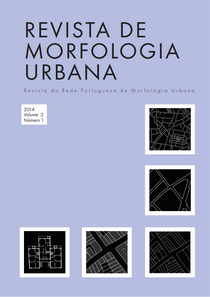Abstract
Conventional methodologies in the study of urban form have not been considering the whole morphological complexity of cities or the degree of irregularity of urban perimeters as they address the physical form of cities within the scope of Euclidean geometry. This paper explores the application of fractal geometry in the study of urban areas, focusing on a number of aspects of physical form related to the fragmentation of urban fabrics, the presence of urban voids and, finally, the existence of self-similarity at different scales of observation. This analysis draws on the research work developed by Frankhauser from the 1990s onwards. Fractal analysis is applied to a set of five cities in the Vale do Rio Pardo, Rio Grande do Sul, Brazil. Over the last years, this set of cities had an uncontrolled pattern of growth. The rapid urban development patterns and the expansion of urban perimeters have led to a type of rarefied territorial occupation with major impacts on the urban fabrics of these cities.
References
Allen, P. M. (1997) Cities and regions as self-organizing systems: model of complexity (Gordon and Breach Science Publishers, Amsterdão).
Azevedo, T. e Christofoletto, A. (2007) ‘Fractais em geografia, conceitos e perspectivas’ Climatologia e Estudos da Paisagem 2, 30-49.
Batty, M. (2003) ‘Agent-based pedestrian modelling’ in Longley, P. e Batty, M. (eds.) Advanced spatial analysis, the CASA book of GIS (ESRI Press, Redlands).
Batty, M. e Longley, P. A. (1994) Fractal cities: a geometry of form and function (Academic Press, Londres).
Benguigui, L., Blumenfeld-Lieberthal, E. e Batty, M. (2008) ‘Macro and micro dynamics of city size distributions: The case of Israel’, CASA Working Paper 139.
Cooper, J. e Oskrochi, R. (2008) ‘Fractal analysis of street vistas: a potential tool for assessing levels of visual variety in everyday street scenes’, Environment and Planning B: Planning and Design 35, 349-63.
Falconer, K. J. (1990) Fractal geometry: mathematical foundations and applications (John Wiley & Sons, Londres).
Feng, J. e Chen, Y. (2010) ‘Spatiotemporal evolution of urban form and land-use structure in Hangzhou, China: evidence from fractals’, Environment and Planning B: Planning and Design 37, 838-56.
Frankhauser, P. (1994) La fractalité des structures urbaines (Anthropos, Paris).
Frankhauser, P. (1998) ‘The fractal approach. A new tool for the spatial analysis of urban agglomerations. Special Issue on Population’, New Methodological Approaches in the Social Sciences 10, 205-40.
Frankhauser, P. e Pumain, D. (2002) ‘Fractales et géographie’, in Sanders, L. (ed.) Modèles en analyse spatiale (Lavoisier, Paris) 301-29.
Frankhauser, P. (2004) ‘Comparing the morphology of urban patterns in Europe a fractal approach’ in Borsdorf, A. e Zembri, P. (eds.) Report COST Action 10 Urban Civil Engineering (COST, Bruxelas) 79-105.
Joye, Y. (2011) ‘A review of the presence and use of fractal geometry in architectural design’, Environment and Planning B: Planning and Design 38, 814-28.
Mandelbrot, B. (1982) The fractal geometry of nature (W H Freeman, Nova Iorque).
Terzi, F. e Kaya, H. S. (2011) ‘Dynamic spatial analysis of urban sprawl through fractal geometry: the case of Istanbul’, Environment and Planning B: Planning and Design 38, 175-90.
Trentin, G. (2012) Dimensão fractal, dinâmica especial e padrões de fragmentação urbana de cidades médias do estado de São Paulo (Instituto de Geociências, São Paulo).
Weidlich, W. (2000) Sociodynamics: a systematic approach to mathematical modelling in the social sciences (Wolfgang Harwood Academic Publishers, Amsterdão).
Os direitos autorais permanecem com os autores, que autorizam a Revista de Morfologia Urbana a publicar o artigo sob uma licença Creative Commons Atribuição (CC-By).

